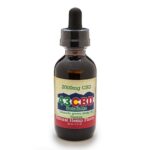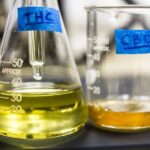
The hemp/Cannabis plant is quickly becoming known as one of the most versatile, medically beneficial * plants that Mother Nature has to offer. The difference between hemp and marijuana is the content of THC. Above .3% THC, the plant is considered marijuana. Below .3% THC, this same species is considered hemp. This is a legal delineation. For this conversation, we will refer to both as Cannabis, as both are, botanically speaking, Cannabis sativa.
Cannabis contains a range of different cannabinoids, or components, with THC (Tetrahydrocannnabinol) and CBD (Cannibidiol) being the two that are in greatest abundance and hold the most significance. Of the over 113 cannabinoids that can be found in the cannabis plant, these two have been the most extensively studied by the medical research community.
Research has led to the discovery of the interaction between THC, CBD, and the body’s endocannabinoid system. This system handles the regulation of a range of different functions, including pain, mood, appetite, memory, sleep, immune response, and the life cycles of cells. Because CBD and THC are very similar to the endocannabinoids naturally produced by the body, ingesting these two compounds can support the healthy function of the system as a whole in specific ways.
Although both of these cannabinoids are essentially cousins originating from the same parent species, the two compounds couldn’t be more different. When examining THC vs. CBD, there are dramatic differences in their psychoactive properties, specific origin, atomic arrangement, interaction with the body’s cannabinoid receptors, and legality.
Here is everything you need to know about the difference between CBD and THC.
Psychoactive Properties
One of the most significant differences between THC and CBD, especially for patients, is that while THC has psychoactive properties, CBD does not. This means that CBD does not produce the traditional “high” feeling that THC does, which is something that many patients find to be a huge benefit. In addition, due in part to this difference, CBD is widely legal for use while THC is much more restricted.
Specific Plant Source
You can find THC and CBD in the flowers, seeds, and stalks of both marijuana and hemp plants, and in a range of other cannabis plants in varying proportions. However, the most abundant source of THC is the marijuana plant, while hemp is the plant that contains the highest levels of CBD.
Many modern-day marijuana plants have been cloned and manipulated by man to increase the THC content, creating inflated concentrations in a variety of strains. Likewise, today’s hemp strains have been selectively bred to be rich and abundant in CBD, resulting in a phenomenal variety of modern genetics.
Different Atomic Structure
THC and CBD are characterized as structural isomers, which is a term used to describe compounds with the same chemical composition but different atomic arrangements. Both CBD and THC have a molecular formula of C21H30O2, with an exact molecular weight of 314.4g/mol. However, it is the actual structure of each compound that is unique.
CBD and THC are both cyclic compounds, with a series of atoms connecting to form a ring. In THC, a closed ring with an ester group is supported, which CBD contains an open ring with a hydroxyl and alkene group.
So, why do these scientific technicalities matter? These slight differences between the atoms of CBD and THC are the reason that each of the cannabinoids interacts with the human body in two dramatically different ways.
Interaction with Natural Cannabinoid Receptors
Both THC and CBD interact with the body through specialized cannabinoid receptors, referred to as CB1 and CB2. In these interactions, both cannabinoids help encourage a natural balance in the body, providing the medical benefits * that many people are familiar with. However, each compound interacts with receptors in very different ways.
THC is much more likely to bind with CB1 receptors, though it will sometimes bind with CB2 receptors. CBD, on the other hand, is not directly attracted to binding with either of these receptors. Rather than direct binding, it indirectly supports cannabinoid agonists. Consequently, CBD actually suppresses the CB1 and CB2 activation that can be caused by THC. These varying interactions are what produce different final effects and method of symptom relief.
As you can see, both THC and CBD have incredible potential to change the world of medicine. This is exactly why our team at 43 CBD Solutions is dedicated to the organic farming of premium hemp and the production of high-quality CBD products. We strive to provide our customers with a range of health benefits in a perfectly natural, legal form. To learn more about CBD and how it might be the supplement that enhances or changes your life, contact our friendly, professional team today.

* The Food and Drug Administration has not evaluated the statements made regarding these products. FDA-approved research has not confirmed the efficacy of these products. These products are not intended to diagnose, treat, cure or prevent any disease. All information presented here is not meant as a substitute for or alternative to information from healthcare practitioners. Please consult your healthcare professional about potential interactions or other possible complications before using any product. The Federal Food, Drug, and Cosmetic Act require this notice.



